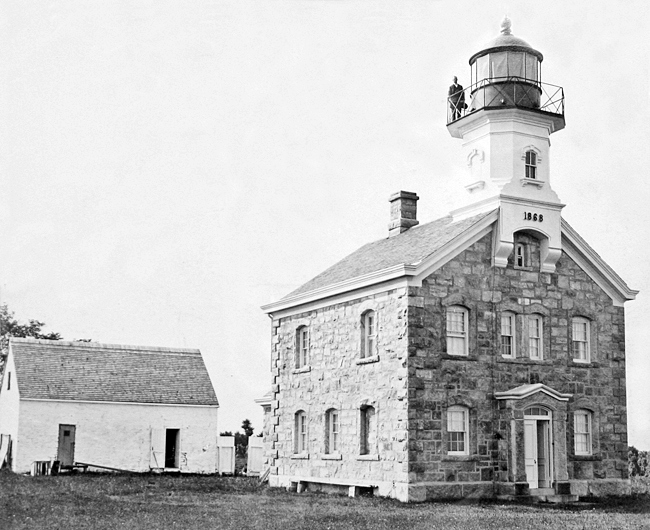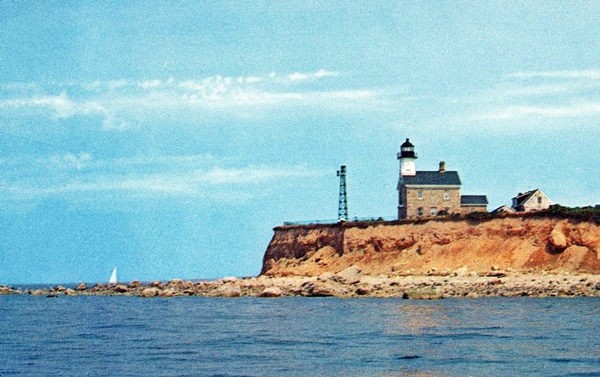
Because of its remote location, Old Field was allocated for early grazing rights and developed neither a large population nor substantial commercial activity. The high bluffs along Long Island Sound made direct water access quite difficult.
Indeed, its remoteness led the Town Trustees to chose Old Field as a site for a hospital to deal with a severe smallpox outbreak in 1770. While the dedication in 1791 of Old Field Road improved accessibility, a 1797 map by the Town of Brookhaven Surveyor showed only two houses (one at Crane Neck and one at the juncture of Mt. Grey and Old Field roads).
For most of the 19th century, the full time residents of Old Field were cutting timber and cordwood; fishing; harvesting crops, salt bay, and oysters; and, for a short time, constructing schooners at the Dickerson Boatyard at Conscience Bay or operating the doomed Old Field Inn (which burned down soon after opening) at Old Field Point. In 1874, Richard M. Bayles, described the settlement of Old Field as “twenty-five houses scattered along a road which leads from the west side of the mill-pond at Setauket, north and east, a distance of three miles. This road opens through a section of beautiful farming land, which lies between the northwest shore of Conscience Bay and the Sound.”
However, the nature of Old Field changed as city dwellers, many of whom would become permanent residents, increasingly built larger and grander residences. In 1901 Eversley Childs created a five hundred acre estate on Crane Neck. Frank and Jennie Melville completed Sunwood in 1919. Ward and Dorothy Melville purchased and started renovating Widewater (originally named Old Field manor) in 1924. The Old Field Improvement Association, active from 1902 to 1926, oversaw many projects, including the Quaker Path extension (providing direct access from Old Field Road to the Stony Brook rail station) and the construction of Mt. Grey Road.
In 1927, the small villages of West Meadow, Oldfield, and Conscience Bay were incorporated as the Village of Old Field which, at that time, claimed 271 residents in about sixty homes. As the Village grew, Old Field saw a decrease in farms and summer residences, and an increase in multi-acre estates and full time residents. Indeed, by the 1950s, Village Historian Mildred H. Gillie wrote, “Old Field is a small incorporated village of about 250 inhabitants…Stately trees and gracious homes, some of them over a hundred years old, line its main thoroughfare, Old Field Road.”
While Old Field has changed dramatically from its earliest days to the present, the one constant has been a people committed to preserving the beauty and serenity of their beautiful village; contributing in countless way to the betterment of
their community and beyond; and extending the welcome hand of friendship to all who visit or decide to make this their permanent home.
The above history draws heavily upon the knowledge and writings of the dedicated historian of our Village, Charlene S. Siefert.

Old Field Lighthouse circa 1885
Shortly after the Civil War but before the arrival of the railroad, a second lighthouse was constructed to accommodate the increasing shipping traffic of Long Island Sound. Construction of the second (and presently existing) lighthouse, built in front of the original, began late in 1868 and was completed in September 1869.
The lighthouse, constructed in the Victorian-Gothic Revival style is similar to the Block Island North Lighthouse (Rhode Island), the Morgan Point And Sheffield Lighthouses (Connecticut), and the Plum Island Lighthouse (Eastern Long Island).
The new lighthouse is considerably larger than the original. The main building of the two story structure measures 30 feet wide by 32 feet long, with the rear one story anteroom about 17 by 19 feet square. The walls, 28 feet high from basement to attic floor, are made from massive two feet thick granite ashlar–blocks of stone hewn or squared for easier and truer construction. In front of the lighthouse, facing Long Island Sound, is an entryway which served as the main entrance to the lighthouse; for visitors, tradesmen, lighthouse inspectors, and seaman all came by boat in those days. The glass and iron octagonal tower, twenty eight feet tall, stands 67 feet above the Long island Sound. The circular beacon area at the top of the tower is six feet in diameter and surrounded by an iron platform. Originally, the tower was painted white but, due to maintenance and durability issues, is now painted black.
The original light in the new lighthouse was a fixed white light with a continuous steady beam. The old reflectors on the light were abandoned in 1856m before the new lighthouse had been built, and were replaced by the fourth order Henry-LePaute Fresnel lens, a “4th order lens” that was the most commonly used type on Long Island Sound lighthouses. It was bright enough to mark the coast and entrance to Port Jefferson Harbor and, in theory, was visible for 13 nautical miles. Kerosene was first used to power the lamp. Today, the electric unit flashes alternating red and green every thirty seconds. It has a 500 watt light with a range of thirty miles.
In 1933, the federal government deactivated the lighthouse, removed the light from the tower, and replaced it with an automated gas light erected on a 50 foot skeleton steel tower built next to the lighthouse. Two years later, in 1935, the lighthouse property was conveyed to the Village of Old Field for “public park” purposes. However, after Pearl Harbor and the American entry into World War II, the federal government seized the property for purposes of national defense. A small Coast Guard contingent occupied Old Field Point. Following the end of the war, the lighthouse was returned to the Village of Old Field. In the summer of 1991, the Coast Guard returned the light to the lighthouse tower room where, under Coast Guard supervision, it once again sends its beam across the waves.

by Lightkeeper John
“A seaside matriarch attired in granite and crowned with iron. An elderly granite lady who watches over the Sound with her flashing eye of red and green.The presence of lightkeepers past is most evident here….the man who wore his brass-buttoned uniform with pride….the man who once tended the old Fresnel lens as though it were the rarest of jewels. Through nights of moonlight and nights of thundering skies this lady of granite with her flashing eye has saved both ships and souls. With her flashing light she’d call to the sailors and ships ‘TAKE CARE! TAKE CARE! STEER CLEAR…THE HARBOR IS NEAR!’ For decades she sat, deemed outmoded and old, her flashing eye shut, her soul in slumber. A new light nearby upon a tower of steel now flashed to the boats on the Sound, but it was only a tower of iron….no heart and no soul. Many years went by and again the “Granite Lady of the Sound” was once more the granite guardian of Old Field Point….her red and green eye a most welcome sight on a storm-tossed night!!”
Additional information on this historical and beautiful lighthouse can be found at:
Barbara Swartz, The Old Field Lighthouse (September 1991)
(Available at Old Field Village Hall)

Mayor’s Desk
Tom Gulbransen
Resolutions define a place as a village.
Relationships among neighbors create community.
Resources preserved for those who come after us become our heritage.
Welcome to Old Field
Welcome flyer from Town
About Old Field, NY
Village News
Latest happenings
Our History
Lighthouse has stories in past
Points of Interest
What to see and do
Village Statistics
Community by the numbers
